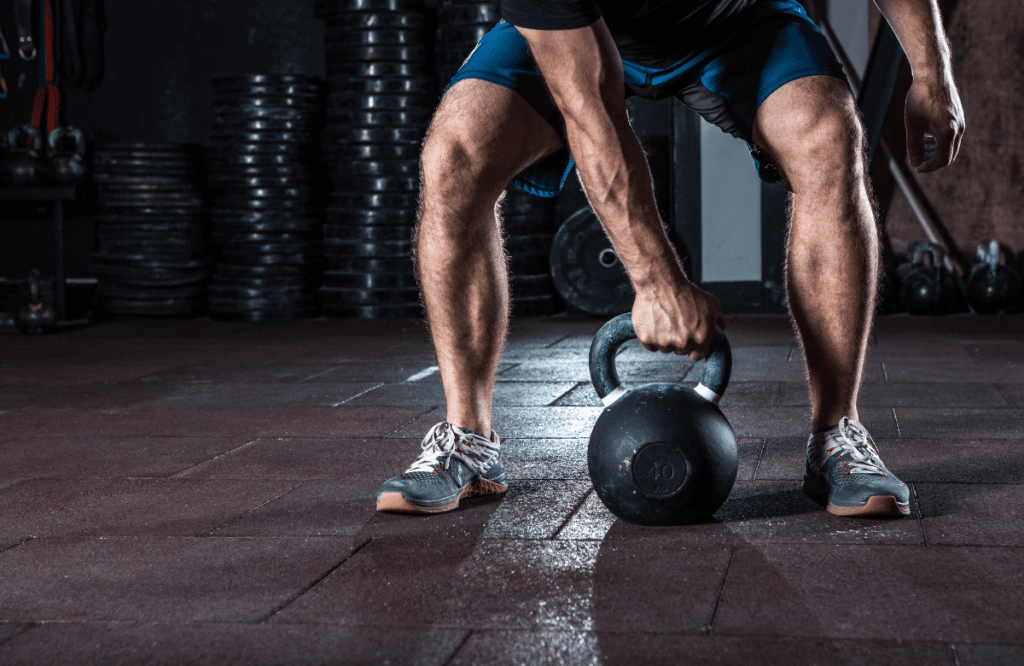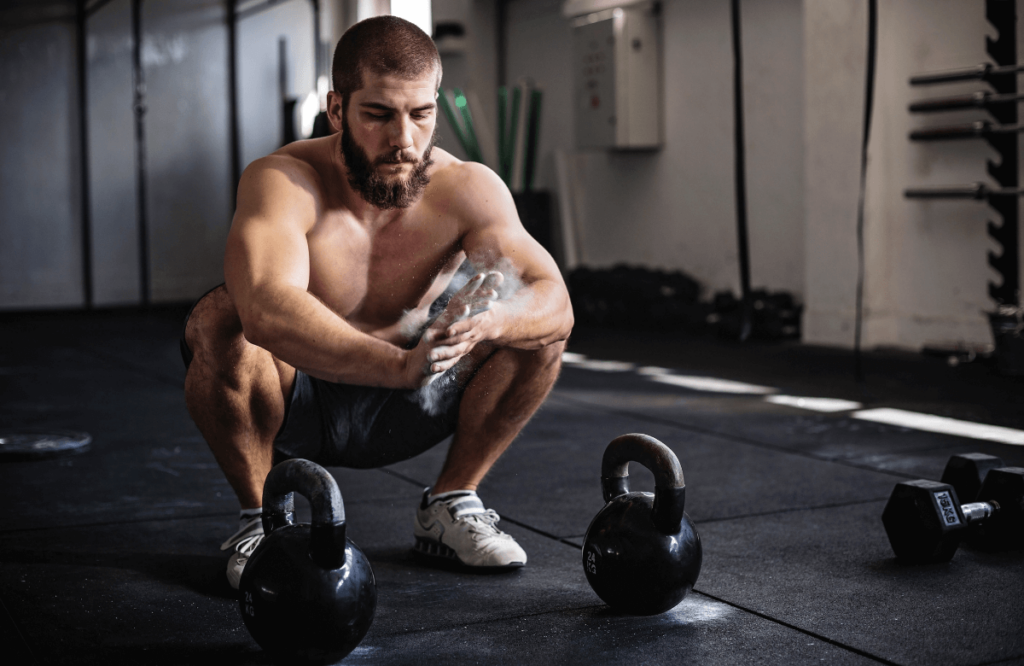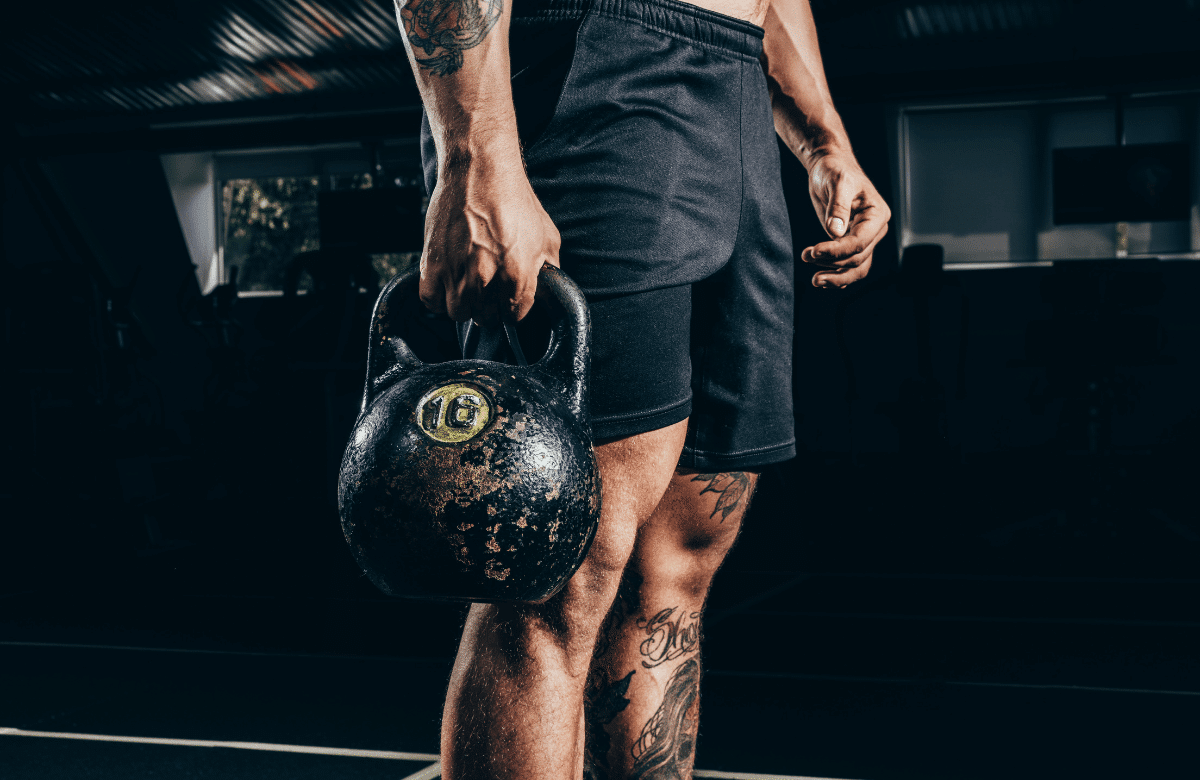It’s no secret that row variations add variety to your upper body routine. Countless movements can strengthen the upper body, build muscle mass, and shed calories.
Many movements gain popularity, including the Kettlebell Gorilla Rows.
If you’ve seen this exercise online, you might wonder if you should add it to your routine or if it’s just a trend. We cover everything you need to know, including the benefits, how to perform it, the muscles worked, common mistakes, and more.
Jump to:
What are Kettlebell Gorilla Rows?
Gorilla Rows are a bent-over row variation, targeting the middle and upper back muscles alongside the lats and shoulders. The upper body exercise requires core strength to maintain the bent-over position, which can enhance abdominal stability and posture.
The gorilla rows position is unique because you maintain a hip-hinge position, similar to the start of a deadlift position, while performing a unilateral row.
This creates an isometric position or a position where you hold the body in the same stance throughout the entire exercise. Isometric positions create tension and engage the hips and lower body.
The non-working arm also plays a role, as you press it down for stability when you lift with the opposite side. The alternating pattern helps you stay balanced while creating a slight rotation through the torso.
Most lifters use the gorilla kettlebell row variation by alternating sides with two weights. It’s possible to use a pair of dumbbells, but you will need to elevate them to mid-shin height before starting.

How to Perform Kettlebell Gorilla Rows
Gorilla Rows are a straightforward exercise using the bent-over row position. It’s best to perform the movement with kettlebells that you can lift comfortably for three sets of 6–12 reps.
If you’re uncertain what weight to use, start light can slowly work your way up until you feel challenged without sacrificing technique.
- Assume a starting position with the feet shoulder-width apart and two kettlebells on the floor between the feet.
- Hinge at the hips to assume a bent-over row position, grabbing the kettlebell handles with a neutral palm-facing inward grip.
- Maintain a firm, flat back and tight core. Contract the lats as you row one weight up to the side of your torso while the other arm presses the opposite weight into the floor.
- Extend your arm to lower the weight before completing the same movement on the opposite side.
- Continue alternating arms for your desired rep range.
Muscles Worked
Gorilla rows are primarily used in upper body routines, but it’s a compound movement that targets several muscle groups simultaneously. Besides the major back muscles, the exercise also targets the shoulders, arms, and core.
Gorilla rows also engages the lower body as you maintain a bent-over hip-hinge position the entire time. Overall, it’s a fantastic exercise for increasing strength, stability, and mobility.
Latissimus Dorsi Muscles

The latissimus dorsi, or lats for short, are located on the sides of your upper back and are the primary muscle activated.
The lats work with the teres major and pectoralis major to adduct, medially rotate and extend the arm.
The muscle is used for climbing activities or when the arms are raised above the head, like in rowing, swimming, or lifting objects overhead. Training the lats will improve your mid-back strength and give you back more width.
Trapezius Muscles

The trapezius, or traps, are on the upper back and provide your back with thickness. The traps are broken into three sections: upper, middle, and lower. Each portion plays a role in shoulder movement, like retracting the shoulder blades.
Gorilla rows engages all three sections but primarily target the middle traps. Training the trapezius muscle can help with posture and may reduce shoulder and neck pain.
Rhomboid Muscles

The rhomboids are two muscles located beneath the middle traps; the rhomboid major and the rhomboid minor. The two muscles work with several other groups in the upper body to move the shoulders and maintain stability.
Deltoid Muscles

The deltoid muscle wraps around the shoulder and is broken up into three heads; the anterior, lateral, and posterior.
All three of the deltoid heads are used in gorilla rows, but the posterior or rear deltoids get the most engagement. The deltoids are critical for shoulder movement and stability, like lifting the arms forward, to the sides, or backward.
The rear deltoid helps with shoulder extension or moving the arm back and away from the body.
Arm Muscles

Gorilla rows primarily target the mid-back muscles, but the rowing motion requires the biceps and forearms. Both muscles help with elbow flexion while strengthening the forearms can improve your grip strength.
The thick handles of the kettlebells can make them more challenging to grip, which can help improve your grip strength and forearm recruitment.
Core Muscles
The core muscles include the abdominis, obliques, and transverse abdominis. These muscles are located in the midsection, helping with stability and balance. Strengthening the core muscles can provide you with better posture, improve other lifts, and reduce the chance of injury.
Lower Body
With the proper hip hinge position, the lower body receives a lot of engagement during gorilla rows. The kettlebell movement won’t add much muscle mass, but the extra recruitment can help you burn more calories and develop more stability.
Kettlebell Gorilla Row Benefits
The kettlebell gorilla row is an exercise that combines elements of the kettlebell row and gorilla rows to provide a full-body workout. Here are some benefits of including the kettlebell gorilla row in your fitness routine.
Full-Body Engagement
Kettlebell gorilla rows are a compound movement, meaning it uses multiple muscle groups simultaneously. It primarily engages the major back muscles, like the lats, rhomboids, and traps.
The movement also recruits the biceps, forearms, and core muscles. The lower body muscles, like the hips, glutes, and hamstrings, also receive engagement due to the hip hinge position. The isometric position creates constant muscle tension in the lower body, helping to improve stability and strength.

Improvements In Core Stability
As you perform the kettlebell gorilla row, your core muscles are actively engaged to stabilize your body and prevent excessive movement. This exercise challenges your core strength and stability, helping you develop a strong and functional core.
Strength Development
By incorporating the gorilla row into your training, you can enhance overall strength. The exercise specifically targets the muscles involved in rowing movements, which can improve your pulling strength and develop a solid and muscular back.
Time Efficient
The kettlebell gorilla row is a compound exercise that targets multiple muscle groups simultaneously, making it a time-efficient option for a full-body workout. It allows you to maximize your training time by working on various muscle groups and movement patterns in a single exercise.
Kettlebell Gorilla Row Variations
There are countless exercise variations and alternatives that target similar muscle groups. Kettlebells are versatile weights used to target the entire body, improving stability, strength, and coordination. You can also use dumbbells, but you will notice a difference in muscle activation.
Single-Arm Kettlebell Row
The Single-Arm Kettlebell Row is a fantastic unilateral variation to incorporate into your upper body routine. Single-arm variations can help you improve muscle imbalances as you train each side independently.
We’ve covered the exercise in more detail, including how to perform it, the benefits, and variations to try in more detail here. For now, here’s a quick guide on how to perform the exercise:
- Start by positioning your body with your left leg forward and bent while resting your left arm on top of your knee.
- Your back will be inclined towards the ground, and it will be supported by your back leg, which is stretched out behind you and slightly bent.
- Utilize your shoulder blade to raise the kettlebell towards your chest or rib cage while bending your elbow.
- Then, lower the kettlebell back down and repeat the movement for your desired rep range.
If you don’t have kettlebells, you can also perform the Single-Arm Dumbbell Row for similar benefits.
Kettlebell Renegade Row
The Kettlebell Renegade Row is a challenging movement that engages the upper body and core. The exercise has a balanced horizontal pull movement pattern, requiring two kettlebells. You must be comfortable maintaining a static plank position to execute the renegade variation.
- Position two kettlebells on the floor shoulder distance apart. Enter a high-plank position by firmly gripping both kettlebell handles.
- Keep your body straight and tight without dropping your hips. Tighten your glutes by squeezing them together.
- Tighten your abdomen and pull one kettlebell upward using the elbows. Press your opposite hand into the opposite kettlebell to maintain balance.
- Take a moment at the highest point of the movement and squeeze your shoulder blades together.
- Lower the kettlebell gradually and maintain control throughout the descent. Repeat the movement on the opposite side for your desired rep range.
Single-Arm Kettlebell Seesaw Row
The Single-Arm KB Seesaw variation is a dynamic, unilateral movement that challenges the supporting muscles. The movement exercises the core and spinal stabilizers due to the unilateral pattern.
It’s a full-body workout that burns calories and strengthens multiple muscle groups.
- Stand with your feet hip-width apart, and place the kettlebell on the ground just inside your right foot.
- Bend your knees and hinge forward at the hips, keeping your torso nearly parallel to the floor in an athletic stance.
- Use a neutral grip to grab the kettlebell handle with your right hand while bending your other arm and keeping your elbow close to your side.
- Lift the kettlebell up, keeping your elbow tucked to your side until your hand reaches your ribcage. Simultaneously, straighten your other arm and reach your hand towards the floor.
- Lower the arm holding the kettlebell towards the floor while retracting your other arm back to the starting position.
- Repeat this back-and-forth motion for the desired number of repetitions.
- Switch sides and complete the same number of reps on the other side.
Common Mistakes to Avoid
With a name like a gorilla row, the movement can seem extremely simple to perform. But there are common mistakes to avoid when performing row variations, like the KB gorilla row. Here are a few pitfalls to look out for so you can get the most out of your training and avoid injury.
Don’t Round Your Back
One common mistake is rounding the back or hunching the shoulders while performing the row. This can strain the lower back and compromise the effectiveness of the exercise. Maintain a neutral spine and proper posture throughout the movement.
Neglecting Core Engagement
Your core muscles play a vital role in stabilizing your body during the kettlebell gorilla row. Failing to engage the core can lead to unnecessary strain on the lower back. Focus on bracing your abs and maintaining core stability throughout the exercise.
Rushing the Movement
Avoid using momentum or jerking motions to perform the KB gorilla row. Instead, focus on controlled and deliberate movements, emphasizing the mind-muscle connection. This allows for better muscle activation and reduces the risk of injury.
Using Excessive Weight
It’s crucial to select an appropriate kettlebell weight that allows you to maintain proper form and control. Using a weight that is too heavy can lead to compromised technique and increase the risk of injury. Start with a manageable weight and gradually progress as your strength improves.
Warm-Up and Cooldown
It’s essential to warm up before every training session and cool off afterward. Doing so will reduce the chance of strain or injury.
Prior to starting the exercise, warm up your body with dynamic stretches or light cardio to increase blood flow and prepare the muscles. After completing the workout, cool down with static stretches to promote flexibility and aid in recovery.
Frequently Asked Questions (FAQ)
What Do Gorilla Rows Work?
The gorilla row is a bent-over row variation that targets the upper body. It primarily engages the back muscles, like the lats, rhomboids, and traps. It also uses the biceps, forearms, and core. The static hip-hinge position engages the lower body, making it a full-body exercise.
How Many Reps for the Gorilla Row?
The kettlebell gorilla row can be performed for higher reps, ranging from 16–20 reps. It’s best to use lighter weights so that you can complete 8–10 reps per side comfortably. So, you might perform three sets of 8–10 reps per side.
Can I Do Gorilla Rows With Dumbbells?
Yes, it’s possible to perform the gorilla row with dumbbells. It’s best to elevate the dumbbells to shin height using a weight plate or platform. Otherwise, you can grip the dumbbells close to a 90-degree angle.














